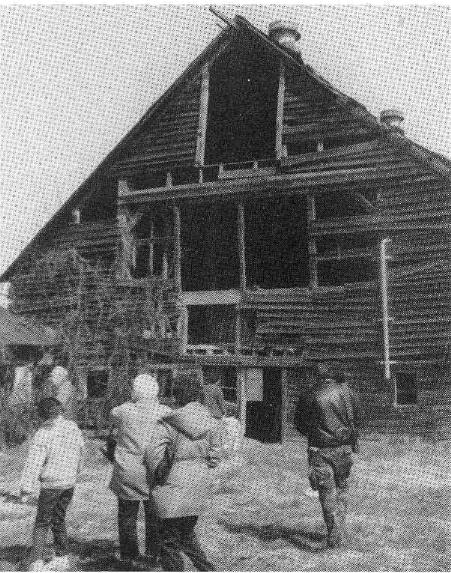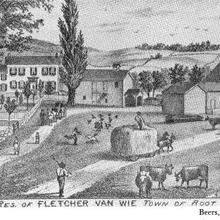About Dutch Barns
Introduction
The New World Dutch Barn, as it has come to be known, is one of the last physical reminders of the pre-industrial agricultural heritage of eastern New York and New Jersey. The efficient, heavy timber structural system adapted from Northern European precedents, reflects the practical construction and engineering skills of the predominately Dutch immigrants who settled the area, and their descendants. These barns are now rapidly disappearing from our rural landscapes and are in urgent need of increased study and preservation efforts.
Historic Legacy
Built in large numbers between 1630 and 1825, New World Dutch barns served as all-purpose working farm buildings in a region dominated by grain farming. These buildings represented the center of historic farm activity during this period, providing housing for farm animals, a facility for threshing grain, and storage for both hay and grain. Although rapidly disappearing from the rural landscape, a few hundred Dutch barns survive in the area originally settled by the Dutch, an area roughly corresponding to the seventeenth century Colony of New Netherland. Concentrations of historic Dutch barns can still be found in rural portions of the Hudson, Mohawk and Schoharie valleys, and in northern and central New Jersey. Examples have also been reported on Long Island, in Pennsylvania, and from the Province of Quebec.
Rural Character
Dutch barns are different from other historic barns in their distinctive shape, arrangement of interior space, and H-shaped structural frames which provide a rigid core supporting the external roofing and walls. With a little experience, searchers can identify these barns in the landscape by their box-like shape, low side walls and broad, steep gabled roofs. Those barns which retain their original characteristics exhibit double wagon doors centered in the gable end, with flanking animal doors at the corners, and wide horizontal siding. One side of the wagon door may be divided in the Dutch fashion. Look for small holes, intended to admit swallows, high in the gable. Although these barns often have been modified with additions, silos, the insertion of a lower story to house dairy cows, and new sheathing materials, the distinctive H-frames and the resulting exterior profile remain as distinguishing characteristics.
Interior Layout
(Click for larger view) On the interior, Dutch barns include a spacious center aisle with a plank floor designed to accommodate unloading wagons and to provide space for grain threshing. The center aisle is typically spanned by three to five massive anchor beams, 20 to 30 feet in length, which form the horizontal members of the H-frame. These beams also once supported sheaves of grain stored on sapling poles in the loft above. The anchor beams usually include distinctive rounded "tongues" which protrude through the supporting columns, where they are secured by wooden pins and wedges. Flanking side aisles provided storage and housing for cows and draft animals. Unlike most other historic barns, the internal structural system characteristic of Dutch barns is relatively protected from the effects of the elements, and can often survive exterior decay for protracted periods of time before collapsing. In summary, this structural system, unlike any in the barns that followed, represents an early and distinct agricultural system and culture.

Preservation Challenges
Like many other symbols of our agricultural past, Dutch barns are rapidly disappearing. Losses are resulting from the deterioration and collapse of abandoned barns, fires, the sale and removal of historic barns in whole or as parts for the construction of contemporary buildings and the outright demolition of these barns due to obsolescence or new development. If the present trend continues unchecked, few of these venerable buildings will survive the next twenty years. (Click photo for larger view.)
As a generation, we have the responsibility to see that these rare and significant artifacts from our agricultural heritage are conserved for future generations to observe, understand, and appreciate. When these barns can't be saved, it is incumbent upon us to record their presence through maps, photographs, measured drawings and the compilation of historical records.
